“In the context of omnipresent telecommunications surveillance, “The Pirate Cinema” makes the hidden activity and geography of Peer-to-Peer file sharing visible.” – The Pirate Cinema
This quote, taken from the abstract written on the website of the artwork, sums up pretty much exactly what we see in the work. It is truly an amazing piece of art, one which uncovers and presents to viewers the invisible network connections happening every second all around the world. As someone who has used torrents before, this work really fascinated me and got me thinking about two different perspectives of torrenting; one from the perspective of the user, and the other from the perspective of the producer of the original work.
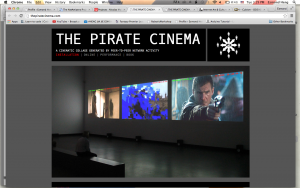
There are 3 main segments in the website, each presenting a different form of the work. The first is the installation of the work. The setup consists of 3 projectors, projecting live-streamed, intercepted data of torrents. Also included is the information of the users – their countries and their IP addresses are shown at the top of each screen. After watching the entire video on the website, I was still hungry for more. The torrents are ever-changing, each scene not more than a second long. This makes it feel as if I were watching snippets of a film – just teasers, without the complete picture. It was also fascinating because I could recognize some scenes as being part of a TV series or movie that I had watched. The quality of the scenes also evoke a sense of a poor quality or lagging stream which gave me a minor headache actually, adding to the sense of claustrophobia of data.
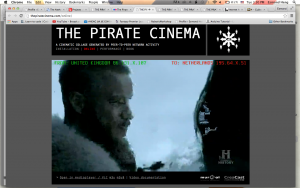 The next segment of the website is an online version of the work. Anyone is now able to view the work, live, on their computers. My first thought was something like, “Wow, now I’m seeing what other people are sharing REAL TIME”, and I was really amazed. I realized that I could actually be involved in the work if I wanted to, all I had to do was download a torrent. This ability to visualize the data being transferred is more than just showing who is downloaded what; it is showing us how the media itself works.
The next segment of the website is an online version of the work. Anyone is now able to view the work, live, on their computers. My first thought was something like, “Wow, now I’m seeing what other people are sharing REAL TIME”, and I was really amazed. I realized that I could actually be involved in the work if I wanted to, all I had to do was download a torrent. This ability to visualize the data being transferred is more than just showing who is downloaded what; it is showing us how the media itself works.
“With Netartizens.tv, we intend to engage a full social and artistic agenda that stretches across disciplinary, geographical, and cultural boundaries, exploring real-time interaction and dialogue between artists, performers, viewers and audience-participants.” – The NetArtizens Project
At this point, I already feel that this work parallels the ideas of NetArtizens.tv. Using data, the artist has managed to achieve a work which spans the entire globe, creating a dialogue between everyone involved, and anyone who wants to be involved.
This series of screenshots are taken from the third segment of the website; this one details the performance version of the work. In it, the artist covers a total of 7 acts. These acts provide a context to the torrent data presented in the work. He talks about the different media (TV shows, movies, music, porn, etc.) being torrented around the world, the different ways in which users label the torrents, and the copyright infringement case between Metallica and Napster, among other things. It revealed alot more about this hidden world of torrents and gave interesting bits of information to think about while viewing the work.
After viewing the installation and the online version, I felt that the video of the performance version was a really neat way to round things off. It provided interesting insights into how the world of torrents work and the way people differentiate between torrents. More than that, it showed me the astounding amount of artistic work available to everyone that without torrents, would probably remain undiscovered and unseen by most of us. To me, this means that the torrent world gives us much more than we can imagine, but at the same time takes away alot from the artists who create the work. I personally would like to see a kind of compromise between the two, but it’s hard to imagine how that would happen.
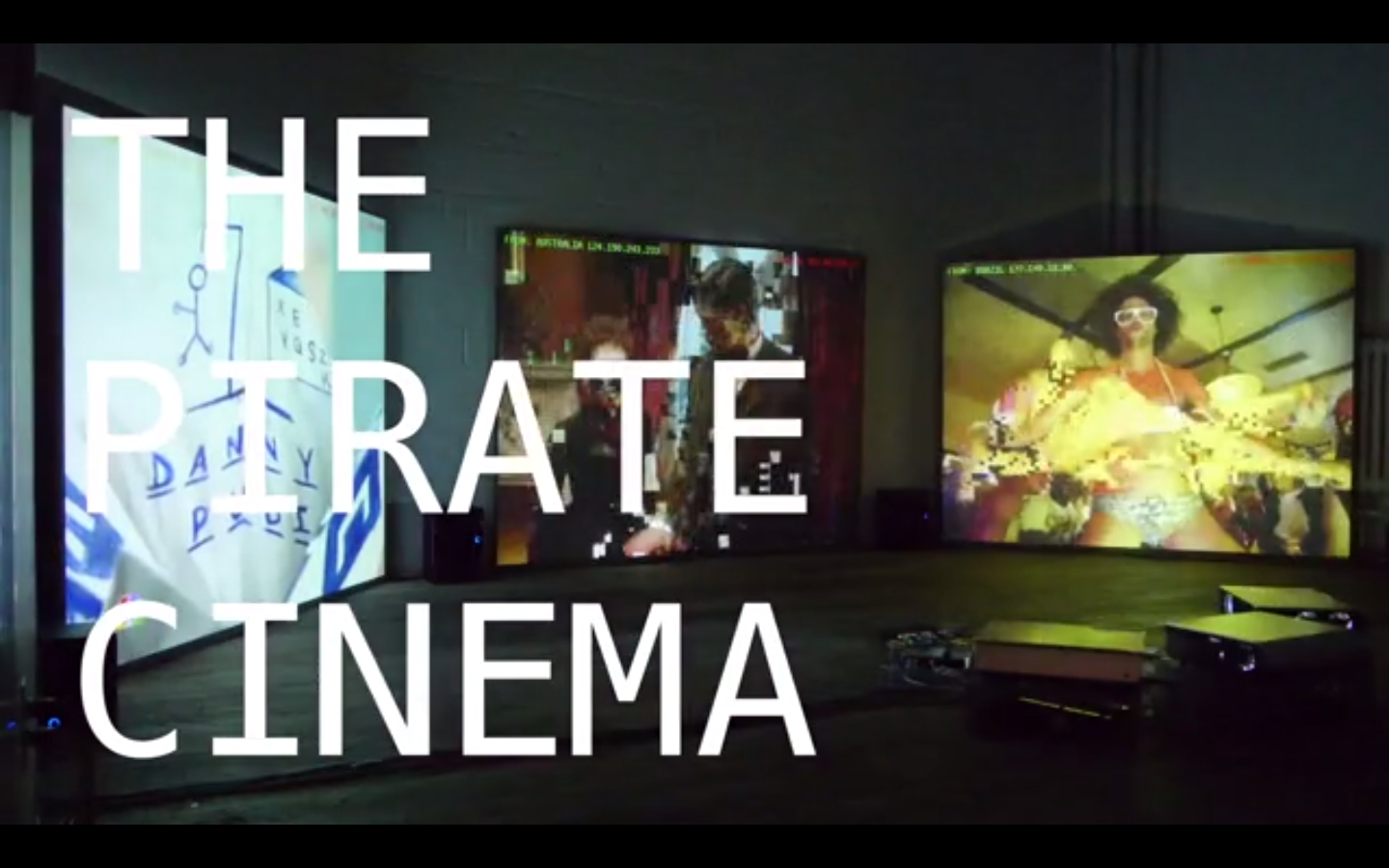
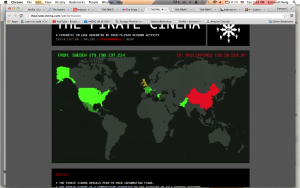
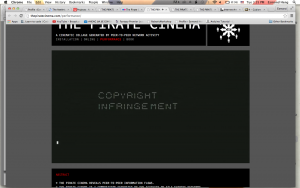
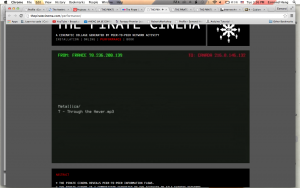
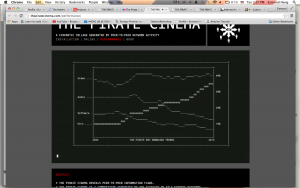
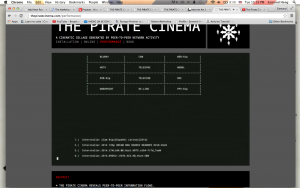
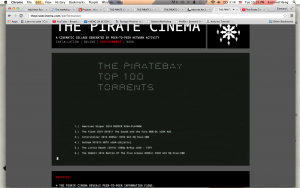
September 2, 2015 at 7:15 am
Esmond, do you think the police might be using this website to catch those who are downloading illegally?
and by showing people’s IP address to the rest of the world, isn’t that a invasion of privacy as well?
September 2, 2015 at 3:17 pm
Apparently, the process is complicated. As like with an email, the content is broken down into different parts and will go through so many different pathways. So the end destination becomes a problem to track. Instead, its easier and legally trackable to find out the source ( uploaders). The installation might be showing you uploaders who had downloaded it and are seeding. That’s what I suspect but do correct if I am wrong.
September 2, 2015 at 4:49 pm
Yeah Kamarule I was actually thinking whether this data will help to catch people who are breaking the law. I guess it would be a simple, if not time-consuming, task to locate some or most of the bigger uploaders of torrents. However I’m not too sure of how the law works regarding these issues, maybe its difficult due to the cross-country nature of sharing files over the internet.
Regarding the invasion of privacy issue, I noticed that the IP addresses were not complete; one of the numbers in the IP address is replaced with an ‘x’. I should have mentioned this in my post but anyway, I suppose this avoids the issue of privacy.
September 3, 2015 at 5:42 am
I found an interview where Nicolas says, “We saw it as a kind of game. Ever since the beginning of the project, we anticipated the operating modes of the system so that we could be presentable regardless of the different ongoing pieces of legislation. For example, an encrypted connection to Sweden (Ipredator / the Pirate Bay) is used to anonymize each machine used in the project. Fragments of the files are encoded and remain on our machine only temporarily.”
September 2, 2015 at 1:17 pm
I like how evident your authorial voice is, in this work.
Regarding your point about how torrent provides users with unfettered access but at the expense of the artists’ intellectual (or creative) property, perhaps contemporary artists [like those of the Open Source Studio (you and I)] should therefore seek to “empower the spectator and deepen his or her experience” (Packer and Jordan, 2002, p. 96) as we learnt in the previous session, rather than seek to jealously guard it from potential torrent pirates amongst their passive, disengaged spectators.
Ascott (cited in Packer and Jordan, 2002, p. 96) advocated the “spirit of cybernetics” to achieve a dialogue between artwork and audience.
Artists who persist in adopting a “nineteenth-century structure of operations” (Ascott, 2002, p. 98), thus fail to include the viewers as active participants in the creative process, inadvertently encourage their “viewers” to pilfer their work, which they view a commodity that is to be transmitted by the artist and received or downloaded by the audience.
Psst… hey, Es… your consummate work, will look even better if you embed the hyperlinks into the text, instead of pasting the entire URL after the quotes.
Reference
Ascott, R. (2002). Behaviourist Art and the Cybernetic Vision. In R. Packer & K. Jordan (Eds.), Multimedia : from Wagner to virtual reality (Expanded ed., pp. 333-344). New York: Norton.
September 2, 2015 at 4:22 pm
Thanks for your reminder about the hyperlinks!
That’s a really good point about empowering the spectator, to avoid creating work they deem as a commodity. Thanks for pointing that out! I guess in a sense this work serves as a good example. Instead of simply sharing the video of the installation, the artist provided the online version which actively involves people due to its real-time format, thus empowering the spectator.
September 3, 2015 at 3:00 am
Esmond, this is excellent work. Tonight in class, let’s discuss how this form of collective narrative is different in the sense that the viewer-participant is probably not aware that they are even participating in a work. How is that different from a viewer action with real intent?